| Reviews & Columns |
|
Reviews DVD TV on DVD Blu-ray 4K UHD International DVDs In Theaters Reviews by Studio Video Games Features Collector Series DVDs Easter Egg Database Interviews DVD Talk Radio Feature Articles Columns Anime Talk DVD Savant Horror DVDs The M.O.D. Squad Art House HD Talk Silent DVD
|
DVD Talk Forum |
|
|
| Resources |
|
DVD Price Search Customer Service #'s RCE Info Links |
|
Columns
|
|
|
Geisha Boy, The
One of Jerry Lewis' and director Frank Tashlin's best gag-filled efforts. Olive Films has released The Geisha Boy, the 1958 Paramount comedy starring Jerry Lewis, Marie "The Body" McDonald, Barton MacLane, Sessue Hayakawa, Robert Hirano (as adorable little Mitsuo), and in her big-screen debut, Suzanne Pleshette. A particular favorite among Lewis fans―in no small part because of a certain rabbit named Harry Hare―The Geisha Boy was one of the titles curiously left out of the recently-released Lewis boxed sets, so it's great to see it here in this gorgeous widescreen transfer. Unfortunately, though...zero extras.
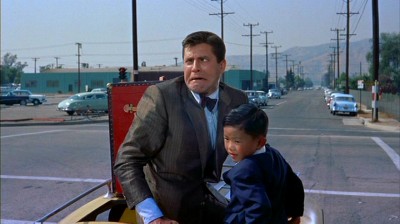
Down-on-his-luck magician Gilbert Wooley (Jerry Lewis) hands over his last buck to the taxi driver (Sid Melton) who drops him off at Los Angeles Airport. Unable to get a booking for the last six months, "The Great Wooley" has finally landed a gig with the Army USO, entertaining troops in Japan. The headliner of the tour, arch, imperious sex symbol Lola Livingston (Marie McDonald), doesn't cotton to Gilbert from the start (she blames his face for scaring her dog), nor does growly C.O. Major Ridgley (Barton MacLane), who hates magicians. On the long flight to Japan, Gilbert gets to know USO liaison Sergeant Pearson (Suzanne Pleshette), who takes a liking to the sincere magician, enough so that she keeps quiet about Gilbert's stowaway: Harry (Harry Hare), a large white rabbit who seems to understand Gilbert and who possesses almost supernatural powers of speed (along with a wicked sense of humor, to boot).
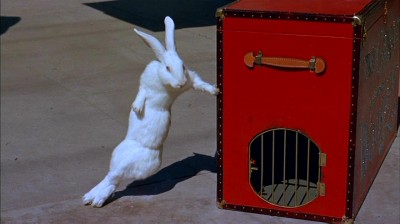
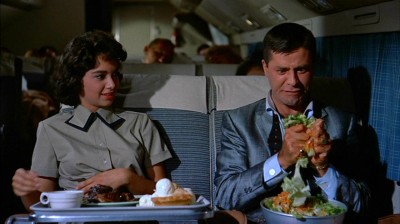
On arriving at Tokyo International Airport, Gilbert tries to apologize to Lola and take the blame for a misunderstanding on the plane involving Major Ridgley in Lola's bed, but he only succeeds in making things worse, humiliating her in front of the waiting press as he accidentally tears away her dress and bounces her down the plane's stairs. This mishap gets The Great Wooley fired; however, it also makes little 6-year-old Mitsuo Watanabe (Robert Hirano) laugh―the first time this has happened since his parents died in an accident. Cared for by his lovely aunt, Kimi Sikita (Nobu McCarthy), who is an interpreter for the Army, and her father, bridge builder Mr. Sikita (Sessue Hayakawa), lonely little Mitsuo immediately latches onto Mr. Wooley, who then begs Major Ridgley for another chance to prove himself to the little boy. Sergeant Pearson comes through and secures a solo tour for Wooley...on the Korean frontlines. Will The Great Wooley make it back to sweet little Mitsuo and beautiful Kimi?
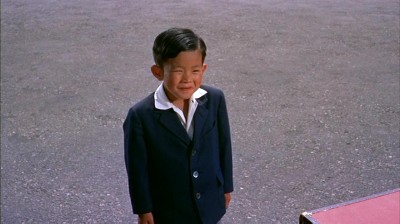
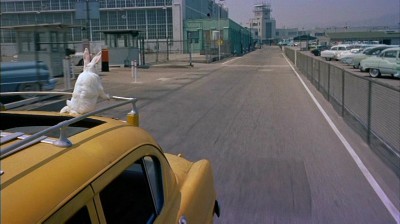
The fourth collaboration between Jerry Lewis and director Frank "Tish Tash" Tashlin, The Geisha Boy was a big hit with the public when it premiered at the end of 1958, validating once again Lewis' solo star status as America's biggest film comedian after the break up of his celebrated duo act with Dean Martin in 1956. It probably didn't hurt The Geisha Boy's b.o. prospects that the year before, director Joshua Logan had a huge hit with the Japan-based romantic war drama, Sayonara, which helped usher in a new period for Hollywood movies that looked favorably (along with plenty of travelogue) on America's former enemy (in a direct reference to Logan's hit, when meeting Kimi for the first time, Jerry states, "You're beautiful...I can understand now why Marlon Brando dug this place."). While Tashlin has some fun with a few gags aimed at minor misunderstandings between Japanese and American cultures (Jerry refusing to bathe in a public bath house, his misunderstanding of what is offered at a geisha house serving food, a few bowing-back-and-forth-gags, and the amusing exhibition game between a Japanese team and the Los Angeles Dodgers where loudmouthed spectator Jerry is alone in causing a disturbance among the polite Japanese crowd), most of The Geisha Boy's biggest laughs come from sight gags divorced from any culture clash commentary. Indeed, The Geisha Boy's sketchily-developed, least-successful aspect is the one that pointedly tries to reference a potentially serious aspect of East-West interaction: Suzanne Pleshette's animosity towards "Oriental girls" who steal away G.I.s with their passive, subservient femininity (it comes out of nowhere in the movie, and at the finale, when Sergeant Pearson vows to Gilbert to ditch her "American girl emancipation" for the next guy she meets, he seems as non-plussed as we the viewers are).
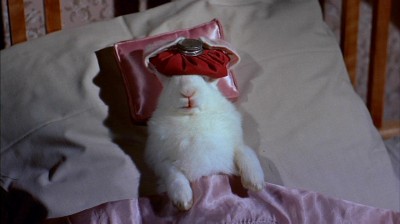
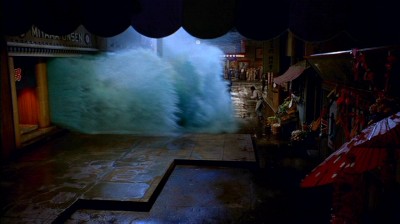
Where The Geisha Boy really flies are in the outrageously funny sight gags that former Looney Tunes animator Frank Tashlin dreams up for Jerry and Harry ("Harry Hare" gets his own "introducing" credit in the opening titles, and too right he should, considering he scores the movie's biggest laughs). Continuing in the same vein they explored in the Martin and Lewis outing, Hollywood or Bust, where a huge Great Dane, Mr. Bascombe, was utilized for some funny gags, Tashlin imparts Harry with an anthropomorphic sensibility that is right out of Bugs Bunny (he even has Harry lean one-armed and cross-legged against his box―Bug's trademark pose). Whether he's posing Harry on top of a speeding taxi (a beautifully dynamic shot from over Harry's shoulder that really pops in VistaVision®), or floating on a raft getting a sunburn, or sliding down a banister like a mechanical rabbit at a greyhound race, or laying in bed with an ice bag on his head, crewing and then stopping when listening to Jerry (probably the biggest laugh in the film), Tashlin's use of Harry here is remarkably facile and fluid, surgically dropped into the film whenever the pace needs a boost (even Harry's foot-thumping is perfectly timed), and orchestrated with a "reality-as-cartoon" sensibility that is laugh-out-loud funny (I haven't heard my little kids laugh that hard in a long time at the delightful Harry).
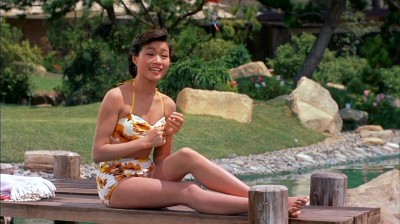
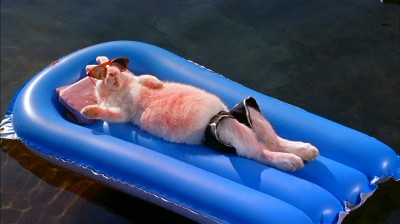
Tashlin's set pieces are impeccably designed and shot, such as the long bookending airplane sequences that open and close the movie. Tashlin lets Jerry board the plane doing his Eddie Mayhoff impersonation, jutting his jaw out in pugnacious indignation at offensive McDonald, before he goes back and plays with the disappearing Harry in the cargo hold. A funny dinner interlude with Pleshette follows (Jerry flipping out, squeezing his salad, is hilarious), before Jerry chases Harry again, with Jerry popping his head into frame like Daffy Duck ("Harry! Don't! Eat! Cherries!"), and we wind up with Jerry in sleeping Lola's bed, rescuing a curious Harry before Barton MacLane is pinned onto Lola from a conveniently-inflated life raft. Tashlin tops this funny, sustained sequence with Jerry's humiliation of McDonald on the Tokyo airport tarmac, giving Tashlin a chance to again indulge in his expected lingerie fetishism as Jerry accidentally tears away her dress (at the beginning of the film, Tashlin deliberately shoots a more complicated overhead shot of McDonald arriving at the airport...so we can get a good look at her impressive cleavage) as she, too, becomes "cartoonized" as well, bouncing down the airplane steps like a beach ball (the final airplane sequences are shorter and devoted more to winding up the plot, but he still has fun with the visuals, including the old bit where a sandwich stolen on the sly has to be turned sideways to fit through a narrow crack in the seats).
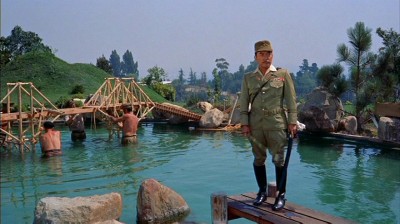
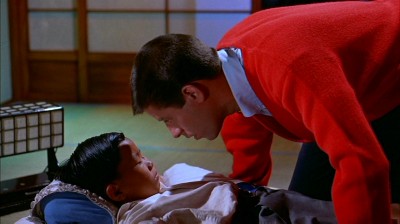
With this cartoon feel to the movie, it's not surprising that The Geisha Boy was a particular favorite on television when I was a kid (and it's gratifying to see this stuff is still funny to kids today). Tashlin's energy is at full power here, throwing out gag after gag with almost all of them working (I've always wondered if that inexplicable overhead shot of the very large woman shaken around in the rickshaw was a set-up for a gag that was later cut from the final print?). My kids didn't get the Paramount stars over Mount Fuji throwaway or the Bridge on the River Kwai reference with Hayakawa and the lifted insert of Alec Guinness, but everything else scored, from huge, jealous baseball player and Kimi's ex Ichiyama's (Ryuzo Demura) tiny little car, to Jerry's mixed-up subtitles when asking a Japanese man for directions (a bit that Altman borrowed for M*A*S*H), to the most impressive gag in the movie: Ichiyama's flooding of a street when he jumps into a public bath (Tashlin doesn't skimp here, creating a huge wall of water rushing after Jerry's stunt double that pounds out into the Paramount city set).
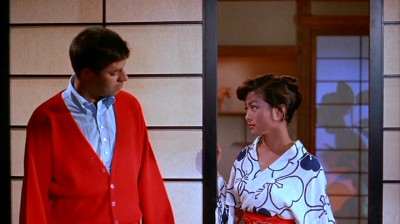
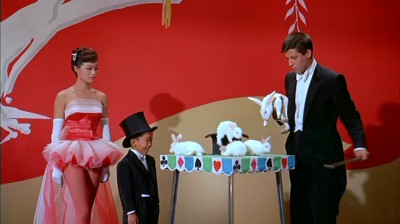
Of course, Tashlin also lets Jerry indulge in a little overt sentimentality, as was Lewis' want at this point in his solo career, but for the most part, his scenes with the gorgeous Nobu McCarthy (she's a doll when spontaneously laughing at Jerry's phony Japanese shtick, or when sporting a dishy bikini) and the too-cute-for-words Robert Hirano (did he ever do anything else?) are played with a sensitive restraint that was missing from some of the baby scenes from Tashlin's and Lewis' previous collaboration, Rock-A-Bye Baby (Lewis the dramatic actor is quite good telling off little Mitsuo for his own good, and what little kid didn't choke up at the sight of Hirano starting to cry?). A little bit of heart, and a whole lot of outrageously funny sight gags marks The Geisha Boy as one of Jerry's and Tish-Tash's best efforts.
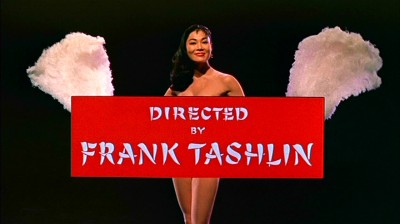
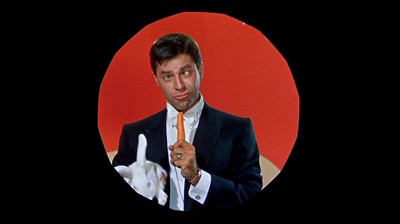
The DVD:
The Video:
Olive has their anamorphically-enhanced widescreen transfer of The Geisha Boy cropped to 1.78:1. I know VistaVision could accommodate variable open matte cropping, so I don't know what ratio The Geisha Boy was projected at during its original run. 1.78:1 looks okay here, though, and the print used by Olive is superlative, with strong, primary colors (the reds do pop nicely) and a super-sharp image. Edge enhancement is acceptable.
The Audio:
The English 2.0 stereo audio track for The Geisha Boy is quite nice, too, with little or no hiss, and a strong re-recording level No closed-captions or subtitles, though.
The Extras:
No extras for The Geisha Boy; not even an original trailer.
Final Thoughts:
Some of Jerry's best sight gags are to be found in director Frank Tashlin's energetic The Geisha Boy. Jerry has finally found a co-star that can get bigger laughs than he, courtesy of Harry Hare, while the slight but sweet subplot of Jerry's relationship with an orphaned Japanese boy and his beautiful aunt is nicely restrained. Overall, one of Jerry's best. I'm highly, highly recommending The Geisha Boy.
Paul Mavis is an internationally published film and television historian, a member of the Online Film Critics Society, and the author of The Espionage Filmography.


|
| Popular Reviews |
| Sponsored Links |
|
|
| Sponsored Links |
|
|
| Release List | Reviews | Shop | Newsletter | Forum | DVD Giveaways | Blu-Ray | Advertise |
|
Copyright 2024 DVDTalk.com All Rights Reserved. Legal Info, Privacy Policy, Terms of Use,
Manage Preferences,
Your Privacy Choices | |||||||














